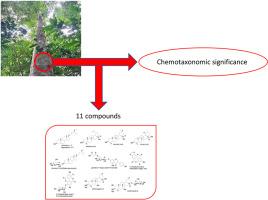Phytochemical study of the stem bark of Erismadelphus exsul Mildbr. (Vochysiaceae) and chemotaxonomic significance of the isolated secondary metabolites
IF 2
4区 生物学
Q4 BIOCHEMISTRY & MOLECULAR BIOLOGY
引用次数: 0
Abstract
Erismadelphus exsul Mildbr. belongs to family Vochysiaceae and is traditionally important to native communities of Gabon for its medicinal value and frequently use in rituals. It has been highly valued for centuries for its application in the treatment of various diseases and the preservation of spiritual health through traditional knowledge. Owing to a deep scientific investigation, eleven known compounds have been isolated from the CH2Cl2/MeOH (1:1) extract of the stem bark using liquid-liquid extraction and chromatographic separation methods, and identified through spectroscopic analysis and physical data in comparison with data from the existing literature. These compounds include β-sitosterol (1), stigmasterol (2), betulinic acid (3), oleanolic acid (4), ursolic acid (5), sitosterol 3-O-β-d-glucopyranoside (6), genistein 7-O-glucoside-6″-malonate (7), 3′-O-methyl-3,4-O,O-methylidene ellagic acid (8), 3-O-methylellagic acid-3′-O-α-rhamnopyranoside (9), bellericagenin A (10) and bellericaside A (11). Current work deals with the isolation and identification of the compounds, along with the discussion of their chemotaxonomic significance for future exploration in successful use in pharmaceutical product development.

黄樟茎皮的植物化学研究。(Vochysiaceae)及其分离次生代谢物的化学分类意义
Erismadelphus exsul Mildbr。属于藿香科,传统上对加蓬土著社区很重要,因为它具有药用价值,经常用于仪式。几个世纪以来,它一直被高度重视,因为它在治疗各种疾病和通过传统知识保护精神健康方面的应用。通过深入的科学研究,采用液液萃取和色谱分离的方法,从茎皮CH2Cl2/MeOH(1:1)提取物中分离得到11个已知化合物,并通过光谱分析和物理数据与已有文献数据进行对比鉴定。这些化合物包括β-谷甾醇(1)、豆甾醇(2)、桦木酸(3)、齐墩果酸(4)、熊果酸(5)、谷甾醇3-O-β-d-葡萄糖苷(6)、染料木素7-O-葡萄糖苷-6″-丙二酸酯(7)、3 ' -O-甲基-3,4-O、o -甲基鞣花酸(8)、3-O-甲基鞣花酸-3 ' -O-α-鼠李糖吡喃苷(9)、蓟草苷A(10)和蓟花苷A(11)。目前的工作涉及化合物的分离和鉴定,并讨论其化学分类学意义,为未来探索在药物产品开发中的成功应用。
本文章由计算机程序翻译,如有差异,请以英文原文为准。
求助全文
约1分钟内获得全文
求助全文
来源期刊

Biochemical Systematics and Ecology
生物-进化生物学
CiteScore
3.00
自引率
12.50%
发文量
147
审稿时长
43 days
期刊介绍:
Biochemical Systematics and Ecology is devoted to the publication of original papers and reviews, both submitted and invited, in two subject areas: I) the application of biochemistry to problems relating to systematic biology of organisms (biochemical systematics); II) the role of biochemistry in interactions between organisms or between an organism and its environment (biochemical ecology).
In the Biochemical Systematics subject area, comparative studies of the distribution of (secondary) metabolites within a wider taxon (e.g. genus or family) are welcome. Comparative studies, encompassing multiple accessions of each of the taxa within their distribution are particularly encouraged. Welcome are also studies combining classical chemosystematic studies (such as comparative HPLC-MS or GC-MS investigations) with (macro-) molecular phylogenetic studies. Studies that involve the comparative use of compounds to help differentiate among species such as adulterants or substitutes that illustrate the applied use of chemosystematics are welcome. In contrast, studies solely employing macromolecular phylogenetic techniques (gene sequences, RAPD studies etc.) will be considered out of scope. Discouraged are manuscripts that report known or new compounds from a single source taxon without addressing a systematic hypothesis. Also considered out of scope are studies using outdated and hard to reproduce macromolecular techniques such as RAPDs in combination with standard chemosystematic techniques such as GC-FID and GC-MS.
 求助内容:
求助内容: 应助结果提醒方式:
应助结果提醒方式:


